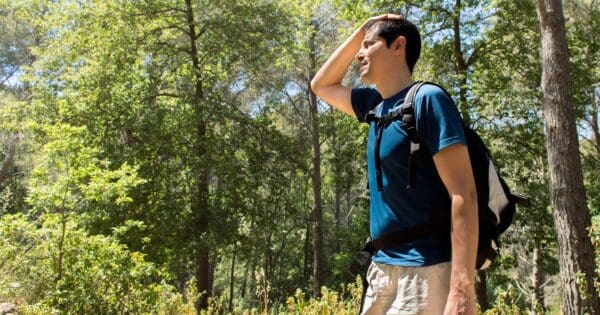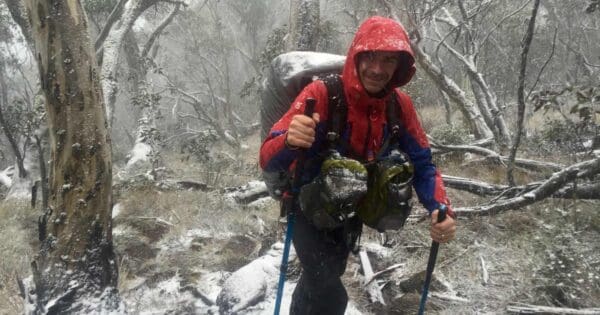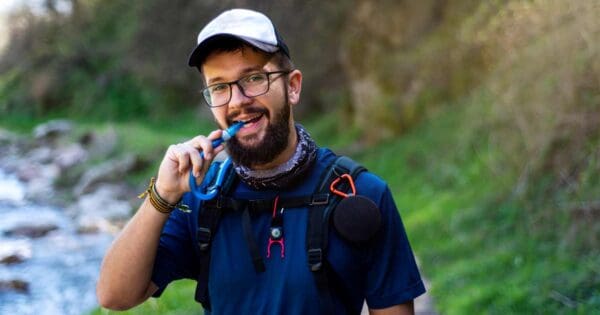Whether you’re training for an extended trek or hiking on the weekends, we’ve all felt the effects of sore muscles, blistered feet, or aching joints. Injuries can prevent you from doing what you are passionate about and hamper training efforts when working towards that next big adventure. With a few tips on how to prevent and treat common hiking injuries, you can keep doing what you love. Some hiking injuries are preventable; others are easily treatable on your own. The suggestions here should never take the place of medical treatment or guidance in your training regimen, but they can help you to begin understanding common hiking injuries and how to manage them.
Blisters
Even the most experienced hikers can get blisters on their feet. Unfamiliar terrain and inclines add more stress to footgear. Wear sturdy shoes that fit well and specialised hiking socks. Found in any outdoors store, hiking socks are made of wicking material, fit snugly (loose material bunches up) and may have extra cushioning. I will always layer my socks for added blister protection. There are also base layer socks such as ArmaSkin that will enhance your blister protection.
Hiking pole blisters
Switch your grip often. Use your wrist loops so you can grip more lightly. You rarely need to white-knuckle those grips to accomplish the goal. In most instances your hands should simply sit in the straps with a light touch on the hand grips. It is good to imagine you are holding a tube of toothpaste so that you don’t grip too tightly. Most importantly, make sure you are using the wrist loops properly: hands should come up into the loop from underneath, not from above.
Knee pain
Many people think of knee pain as unavoidable as you get older. In cases of past injury or other pre-existing conditions it can be difficult to manage, but for most people knee pain can be prevented. Regularly stretching your quads and hamstring muscles can minimise tension on the joint, a common cause of pain. Hiking with hiking poles is extremely helpful to individuals with a predisposition toward joint pain. Hiking poles allow for a better distribution of weight with each step.
Shoulder pain
In order to prevent back pain, you should take great care in picking out a pack with the proper fit. Ask for help from a professional at whichever outdoor store you are purchasing from. You will want to test the pack in person (fully loaded) before you buy. It is also important that you load your pack properly so that weight is distributed in a way that will not pull on your shoulder muscles. The load of your pack should be riding close to your body and most of the weight should be distributed across your hips.
Low back pain
Low back pain is often the result of sitting for extended periods of time, whether at a desk or during your commute. Sitting for long periods of time can cause our hip flexors and hamstrings to get tight, creating a muscular imbalance that strains the lower back. Stretching out the hips often, and especially before a hike, can help. There are many easy hip-opening stretches to help prevent this.
Foot arch pain
A lot of people switch boots a dozen times and still experience arch pain before finally giving up hiking altogether. Stretching may be all you need though. Yes, it’s possible to stretch your feet, and you should. Like many of the solutions here, this should be done on a regular basis and just before hiking. Try kneeling with your knees on the ground and your feet under your buttocks. Your toes should be on the ground as if you were standing on them (pointing forward) so the arches of your feet are exposed fully to anyone standing behind you. If it’s comfortable, try hinging your upper body back a few inches to add more intensity. The most common reason for this sort of pain is plantar fasciitis which can be prevented, but if the pain persists you should see a doctor.
Twisted/Sprained ankle
If you’re hiking on an uneven trail that contains rocks, hidden obstacles, or slippery surfaces, a twisted ankle can be hard to avoid. While some twists can be fixed by the “walk it off” approach, others need a little more attention if you intend to finish your hike. To avoid these time-sucking injuries, wearing the appropriate boots with ankle protection is a good place to start. Beyond that, carrying a hiking pole or some kind of stabilizer will help you balance your steps. If you do twist your ankle to the point of needing to take a seat, be sure to elevate the injury, know how to make a proper ankle brace, and take a rest day if you can afford it to let the swelling subside. If you happen to be near a creek or river I would suggest soaking your foot for 20 minutes in cold water to help reduce the swelling.
Muscle cramping
Nothing is more debilitating than having your legs cramp with every step you take, or that feeling of your toes curling in on themselves as you lay in your tent at night. Cramping is another common hiking injury that is commonly produced by dehydration. Sounds simple enough then, to avoid cramping make sure you are drinking a lot of water. But sometimes in the heat of the moment, especially if the moment is particularly cold, it can be hard to remember to drink the appropriate amount of fluids. Stretching before your big hike can help, and if you find yourself succumbing to a painful cramp, stretching further can alleviate some of the pain. Consider applying hot and cold temperatures to the cramp and refuelling with electrolytes. These solutions can often get you the rest of the way home.
Skin injuries
Another common injury on hiking trails is skinned knees or elbows that occur when we neglect to watch the ground or our surroundings. Tree roots and loose rocks can cause slips and falls and branches can scrape the face, neck, arms and legs. You can always pack a small first-aid kit, but being aware of your surroundings is the most important step you can take. I also always wear long pants when I am hiking to help minimise the scrapes and bumps on my shins. A long sleeve top will also protect your arms.
Chaffing
Even if you don’t like discussing the area between your legs the irritation of chaffing can put a real damper on your hiking experience. This common hiking injury isn’t cured by long sleeves either, instead choosing the appropriate active underwear over your average cotton briefs will go a long way in avoiding the “long day in the saddle” look at night. Think wool or synthetic nylon when choosing your adventure undies, and if you still find yourself scratching at places that shouldn’t be scratched in public, a good handful of body powder can go a long way. I would also recommend not swimming in salt water during your hike as the salt residue will lead top painful chafing as the day progresses.
Joint injury
You can do more than skin your knee if you trip or slip on the trail. Sprained ankles and knee injuries can result from a fall on uneven terrain. Prevention through attention – note your surroundings and step with care because limping back or having to be carried back to civilisation is a drag on everyone concerned. If you experience joint injury to the point of needing to take a break, be sure to elevate the injury, know how to make a proper brace, and take a rest day if you can afford it to let any pain and swelling subside.
Swollen hands
Your blood flows really well while hiking, which is a good thing. If it’s causing uncomfortable swelling in your hands though, try looping your thumbs into your pack straps somewhere, level with or higher than your heart. This stops the centrifugal force that is pushing too much blood into your hands. Using hiking poles can also help.
Headache
This can be a tricky one, but there are a few common and very treatable reasons hikers get headaches while on the trail.
The most obvious reason for a headache while hiking is dehydration. If it improves when you lie down, this is usually the case. Solution: drink more water. Try doubling whatever you’re drinking now up to 1 litre per hour. Skip any electrolyte additions and instead have a few salty snacks. For snacks, it is sometimes best to avoid peanut butter, peanuts, and chocolate, which can exacerbate a headache in some people.
If your headache does not get better when you lie down, or if it feels better when you’re standing up, you may be suffering from hyponatremia; meaning you’ve drank too much water and need more salts, sugars, and electrolytes in your bloodstream. Take a break and have the saltiest snack you can find (or two). Try to urinate and consider limiting your water for the next few hours if you’ve been drinking more than 1 litre per hour. Add an electrolyte powder to your water for the rest of your hike.
Stomach ache
Stomach ache can be related to over-hydration. Try drinking less water or, and having a small snack or two to help process that water through your body. Heat can also cause an upset stomach in some people. The best cure for this reaction is relaxation and shade. If you drink contaminated water from a creek or river this can also upset your digestive system. To prevent this, always filter or treat your water before consuming.
Constipation / Diarrhea
It’s a taboo conversation topic at the dinner table, but open communication about your digestive condition is an important safety factor on the trail. An upset stomach is not only an inconvenience to your overall mood and performance, but left untreated it can lead to gut-busting medical emergencies. Combined with the extra exercise and trail food diet, stomachs can respond differently to hiking life. Diarrhea can most commonly be caused by dehydration or bacterial infection and can be prevented by staying hydrated, cooking all food properly (and avoiding unfamiliar berries) and treating all water you consume. Constipation can be caused by many different reasons, and on the trail it can be associated with new diets and physical and mental stress. By carrying a small supply of Imodium and Laxatives, it can help things go a little smoother.
Dehydration
We live in a dry climate and dehydration can happen faster than you think, even on a short hike. Prehydrate–drink before you start. Many experts say to drink 250ml every few kilometres. My recommendation is that you should consume 250ml every 30 to 45 minutes. Keep the water flowing into your body even if you don’t feel thirsty. Wearing a Camelback type hydration system is one of the easiest ways to carry a volume of water. By the end of a 4-hour hike, you should have consumed two litres of water and you should be able to go to the toilet. Urine that is light yellow (straw colour) is a good indication that you’re getting enough fluid. If you don’t need to urinate then all the water you drank left your body as perspiration and you still need to drink more water to re-hydrate. Following a hike, you should drink additional water with electrolytes until you need to use the toilet. I don’t mean scull it down, just drink half a cup every 5 minutes or so.
Insect bites
Depending on where your hike takes you, you can run into any manner of flying, stinging creatures. Apply insect repellent if hiking near water or in any area you know has biting insects. If you have a severe insect allergy, you should always carry appropriate emergency medicine (i.e. epi pen). Covering up with loose clothing is also an excellent prevention as the creepy crawlies will have greater difficulty locating a nice area of skin to bite.
Sunburn
Sunburn is always a danger in Australia, even on a cloudy day. Always apply sunscreen before you begin your hike, and re-apply sunscreen periodically throughout the day. Pay particular attention to re-application after sweating a lot or getting wet in in rain, creeks and rivers.





